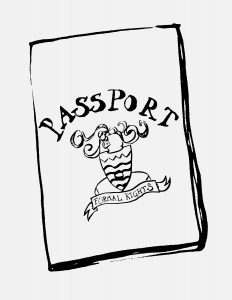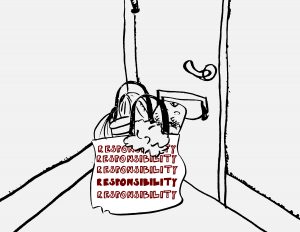Citizenship
Sheryl-Ann Simpson
Sheryl-Ann Simpson is an Assistant Professor in the Department of Geography and Environmental Studies at Carleton University. She studies citizenship because she is interested in how people can make change in their communities and how we can move together towards greater equity and social justice.
Who gets to belong?
When flying from Europe to North America, everyone lines up to pass through an exit check where all the folks with burgundy passports from European countries breeze through, while the blue, black or green passport holders from African, American, Asian, or Pacific countries get some extra attention. When they get off the plane in North America, the burgundy passport holders end up in the long line, while the folks with navy passports from Canada and the U.S. are quickly waved through.
Passports prove formal citizenship, so they come with a set of formal rights. For example, having a Canadian passport means you can always travel back to Canada, to live and work there. That passport also gives you the right to vote in elections—one form of being involved in making decisions about what the country should be like in the future.

People with different passports have different formal rights. Someone with a Brazilian passport is free to travel to Brazil at any time, to live, work and vote there. Someone with a Canadian passport needs a visa to enter Brazil—special permission if they want to stay and work—and can’t vote in elections. Passports are one way of showing who is a citizen: who belongs, who gets to move across a border, who gets to stay in a country, and who gets to be a part of decision making in the country.
Having the same passport is supposed to mean that you get the same formal rights, but that’s not always the case. It was only in the 1980s, for example, that British women became able to pass on citizenship to their children born outside of the U.K. Apartheid laws in South Africa officially created different tiers of citizenship based on race, as defined by the government. And all around the world, we see situations where people have more or less access to their rights, based on race, caste, class, gender and sexuality, age, ability, and disability.
In 1948, the United Nations published the Universal Declaration of Human Rights, which was a response to the violence and harm of the Holocaust and World War II. The Declaration set out rights that everyone should have access to, regardless of what passport they carry, and even if they don’t carry a passport. Importantly, various of these rights relate explicitly to care. For example, when facing persecution, individuals ought to have the right to seek asylum, the right to social security, and the right to rest and leisure.
As the COVID pandemic rolled across the globe, people organized to make sure that neighbours were taken care of, often dropping off groceries for those folks who couldn’t go out themselves. Dropping off groceries can be part of an active citizenship, in which figuring out who belongs and who should get to make decisions relates to taking responsibility for the community. Checking in on a neighbour is one way you can do that; running a business like a grocery store that also supports the community could be another. Volunteering, getting involved in politics beyond just voting, and taking care of the rest of the environment are other ways one can demonstrate responsibility.
Active citizenship also cuts across the lines of formal citizenship. Someone might carry a passport, but would never think to drop off groceries for a neighbour. Someone might live in a country where they don’t have formal citizenship, but they might still look out for neighbours and always try to be responsible for the care of those around them.

In nation states in the Global North, like Canada, the U.K., the U.S., and European countries, citizenship tends to focus more on formal status and rights than on actions and responsibilities. But there are other ways of deciding who belongs and who gets to make decisions. Action and responsibility are at the centre of ideas around kinship in, for example, Nêhiyaw[1], Métis[2], Anishinaabe[3], and Mushkegowuk[4] worldviews. In these contexts, kinship centres around responsibility and relationships. For example, people are expected to take actions to be in good relations with kin and to regularly renew those relationships. Further, they are expected to act in ways that do not harm kin, but rather support the thriving of kin. Importantly, kinship also extends beyond human beings to plant, animal, elemental, and spirit beings. In this view, humans have responsibilities to those beings as well.

Gardening means constantly deciding what belongs and what doesn’t. A tomato plant growing in your tomato patch? Great. A tomato plant that’s found its way into your rose bushes? Well, suddenly that’s an unwelcome weed. Milkweed, a main food source for monarch butterflies, was classified as a noxious weed in the Province of Ontario until the mid-2010s, so it was illegal to grow and you had to remove it if you found some in your garden. Today there are campaigns trying to encourage people to grow milkweed to support the endangered monarch populations.
Choosing what belongs (or not) is a way of deciding what plants have membership in the garden. Membership describes who is a part of the citizenship community. Who is recognized as belonging by other citizens, who is cared for, and who is excluded (or to go back to our garden, weeded out)?
Nation state governments have largely taken on the role of gardener, setting up laws about who will be recognized as a member. A lot of these laws are focused on keeping people out, on limiting movement, for example, through all of those elaborate border checks where passports have to be shown. They focus on weeding out—on making sure specific people stay in their designated areas.
But there are other ways to think about membership. Proponents of the No One Is Illegal movement, for example, argue that people should be able to move freely—to live, work, play, worship, and learn where they want, and where it is safest for them. They also argue that cities should provide sanctuary, where people would be taken care of without fear that they will be arrested or deported. For example, if you were living somewhere without formal status you could still go to the doctor, or send your kids to school, and the people who run those services wouldn’t ask about or report your status to anyone else. Advocates of sanctuary cities envision a garden in which there really aren’t any weeds. Instead, plants from all over can jumble up against one another, and all receive care. Taking the metaphor a step further, and following ideas from permaculture, in which gardeners try to learn from existing ecosystems, having a broad diversity of plants would considered a strength.
Ideas around citizenship are one way to help answer questions about who belongs, who gets to make decisions, who receives care, and who is excluded. Depending on our theory of citizenship, we will answer these questions differently. While a theory of formal citizenship is the least generous in terms of who counts, adding ideas about responsibilities and active citizenship let us focus on how we want to live together, while ideas about membership can help us think about citizenship’s associated rights, responsibility, and care, as something that everyone deserves.
Discussion Questions
- In your own words, describe the different types of citizenship explained above.
- Think of a time when you felt like you belonged. What helped you to feel that way? Where were you, what were you doing, and who were you with? What effect did this feeling of belonging have on you? Then think of a time when you felt like you didn’t belong, and answer the same questions.
- Consider the concept of active citizenship. What are some of the responsibilities you take on to care about your own community? How are these activities significant to you?
- There are different types of citizenship described above. Which do you think should be used to decide who belongs?
Additional Resources
Alexander, J. (1994). Not just (any) body can be a citizen: The politics of law, sexuality and postcoloniality in Trinidad and Tobago and the Bahamas. Feminist Review, 48: 5-23.
Bauböck, R. (2015). Three levels of citizenship in the European Union. Phenomenology and Mind, 8:66-76.
Berlant, L. and Warner, M. (2002). Sex in public. In M. Warner, Publics and Counterpublics. New York: Zone Books.
Freshour, C. (2017). “Ain’t no life for a mother!” Racial capitalism and the crisis of social reproduction. Society and Space. November 17. https://www.societyandspace.org/articles/aint-no-life-for-a-mother-racial-capitalism-and-the-crisis-of-social-reproduction/
Horst, C., Erdal, M.B. and Jdid, N. (2020). The “good citizen”: Asserting and contesting norms of participation and belonging in Oslo. Ethnic and Racial Studies, 43(16): 75-95.
Isin, E.F. (2002). Being political: Genealogies of citizenship. Minneapolis: University of Minnesota Press.
Kamugisha, A. (2007). The coloniality of citizenship in the contemporary Anglophone Caribbean. Race & Class, 49(2): 20-40.
Lawson, V. (2009). Instead of radical geography: How about caring geography? Anitpode, 41(1):210-213.
Marshall, T.H. [1950] 1998. Citizenship and class. In G. Shafir (Ed.) The citizenship debates. Minneapolis: The University of Minnesota Press.
No One Is Illegal: https://nooneisillegal.org/
Ong, A. (1999). Flexible citizenship: The cultural logic of transnationality. Durham: Duke University Press.
Staeheli, L.A., Ehrkamp, P., Leitner, H. and Nagel, C.R. (2012). Dreaming the ordinary: Daily life and the complex geographies of citizenship. Progress in Human Geography, 36(5) 628–644.
Sultana, F. (2020). Embodied intersectionalities of urban citizenship: Water, infrastructure, and gender in the Global South. Annals of the American Association of Geographers, 110(5):1407-1424.
UN Declaration of Human Rights: https://www.un.org/en/about-us/universal-declaration-of-human-rights
References
McAdam, S. (Saysewahum) (2015). Nationhood interrupted: Revitalizing nêhiyaw legal systems. Vancouver: UBC Press.
Todd, Z. (2019). Decolonizing Prairie public art: The further adventures of the Ness Namew. In Heather Dorries, Robert Henry, David Hugill, Tyler McCeary and Julie Tomiak (Eds). Settler city limits: Indigenous resurgence and colonial violence in the urban Prairie West. Winnipeg: University of Manitoba Press.
Craft, A. (2013). Breathing life into the Stone Fort Treaty. Vancouver: UBC Press.
Daigle, M. (2018). Embodying kinship responsibilities in and through nipi (water). In Jim Elllis (Ed.) Water rites: Reimagining water in the West. Calgary: University of Calgary Press. 1–11.

